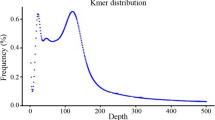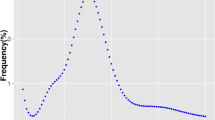Abstract
In the present work, genomic DNA libraries for 18 underutilized crop species (including 11 dicot and 7 monocot species) were enriched for several di- and tri- nucleotide microsatellites by using an optimized procedure. About 500–960 clones from each library were sequenced and all the sequences were characterized to have a comparative look on relative abundance, composition and length variations of perfect microsatellites among different crops. Sequence analysis revealed contrasting differences in the abundance of di- and tri-nucleotide microsatellites with the predominance of tri-nucleotide microsatellites in 11 crops and that of di-nucleotides in other 8 crops. Among di-nucleotide microsatellites, AG/GA class was the most abundant in all the crops except for four crops in which AC/CA class was predominant. Among tri-nucleotide repeats, AGC/GCA/CAG class was the most abundant in eight crops followed by AGG/GGA/GAG class in four crops, whereas in the remaining six crops, the most abundant class was highly variable. The longest di- and tri-nucleotide repeats were observed in Chinese cabbage and mungbean with the average lengths of 70 and 57 base pairs, respectively. These observations revealed species-specific in the distributions of microsatellite repeat motifs. The present study provides highly valuable information that can be useful in targeted development of specific microsatellites markers for genetic analysis of these underutilized crops.


Similar content being viewed by others
References
Akkaya MS, Bhagwat AA, Cregan PB (1992) Length polymorphism of simple sequence repeat DNA in soybean genetics. Genetics 132:1131–1139
Beckmann JS, Weber JL (1992) Survey of human and rat microsatellites. Genomics 12:627–631
Condit R, Hubbell SP (1991) Abundance and DNA sequence of two-base repeat regions in tropical tree genomes. Genome 34:66–71
Dixit A, Jin MH, Chung JW, Chung HK, Ma KH, Park YJ et al (2005) Development of polymorphic microsatellite markers in sesame (Sesamum indicum L.). Mol Ecol Notes 5:736–738
Ellegren H (2004) Microsatellites: simple sequences with complex evolution. Nat Genet 5:435–445
Fisher PJ, Richardson TE, Gardner RC (1998) Characteristics of single- and multi-copy microsatellites from Pinus radiata. Theor Appl Genet 96:969–979
Gacy AM, Goellner G, Juranic N, Macura S, MacMurray CT (1995) Trinucleotide repeats that expand in human disease form hairpin structures in vitro. Cell 81:533–540
Goff SA, Ricke D, Lan TH et al (2002) A draft sequence of the rice genome (Oryza sativa L. ssp. japonica). Science 296:92–100
Gupta PK, Varshney RK, Prasad M (2002) Molecular markers: principles and methodology. In: Jain SM, Ahloowalia BS, Brar DS (eds) Molecular techniques in crop improvement. Kluwer Academic Publishers, Dordrecht, Netherland
Hammer K, Heller J (1998) Promoting the conservation and use of underutilized and neglected crops. Schr Genet Ressour 8:223–227
Jarne P, Lagoda PJL (1996) Microsatellites, from molecules to populations and back. Trends Ecol Evol 11:424–429
Jung S, Abbott A, Jesudurai C, Tomkins J, Main D (2005) Frequency, type, distribution and annotation of simple sequence repeats in Rosaceae ESTs. Funct Integr Genomics 5:136–143
Jurka J, Pethiyagoda C (1995) Simple repetitive DNA sequences from primates: compilation and analysis. J Biol Chem 40:120–126
Kantety RV, Rota ML, Matthews DE, Sorrells ME (2002) Data mining for simple sequence repeats in expressed sequence tags from barley, maize, rice, sorghum and wheat. Plant Mol Biol 48:501–510
Katti MV, Ranjekar PK, Gupta VS (2001) Differential distribution of simple sequence repeats in eukaryotic genome sequences. Mol Biol Evol 18:1161–1167
Kijas JMH, Fowler JCS, Garbett CA, Thomas MR (1994) Enrichment of microsatellites from the citrus genome using biotinylated oligonucleotide sequences bound to streptavidin-coated magnetic particles. Biotechniques 16:656–662
Kim KW (2004) Developing one step program (SSR Manager) for rapid identification of clones with SSRs and primer designing. Thesis (M.Sc.), Department of Plant Science, The Graduate School, Seoul National University, Republic of Korea
Kumpatla SP, Mukhopadhyay S (2005) Mining and survey of simple sequence repeats in expressed sequence tags of dicotyledonous species. Genome 48:985–998
Lagercrantz U, Ellegren H, Andersson L (1993) The abundance of various polymorphic microsatellite motifs differs between plants and vertebrates. Nucleic Acids Res 21:1111–1115
McCouch SR, Chen X, Panaud O, Temnykh S, Xu Y, Cho YG et al (1997) Microsatellite marker development, mapping and applications in rice genetics and breeding. Plant Mol Biol 35:89–99
Metzgar D, Bytof J, Wills C (2002) Selection against frameshift mutations limits microsatellite expansion in coding DNA. Genome Res 10:72–80
Mitas M (1997) Trinucleotide repeats associated with human disease. Nucleic Acids Res 25:2245–2254
Mohan M, Nair S, Krishna TG, Yano M, Rhodes I (1997) Genome mapping, molecular markers and marker-assisted selection in crop plants. Mol Breed 3:87–103
Morgante M, Olivieri AM (1993) PCR-amplified microsatellites as markers in plant genetics. Plant J 3:175–182
Morgante M, Hanafey M, Powell W (2002) Microsatellites are preferentially associated with non-repetitive DNA in plant genomes. Nat Genet 30:194–200
Mun KH, Kim DJ, Choi HK et al (2006) Distribution of microsatellites in the genome of Medicago truncatula: A resource of genetic markers that integrate genetic and physical maps. Genetics 172:2541–2555
Nelson RJ, Naylor RL, Jahn MM (2004) The role of genomics research in improvement of “Orphan” crops. Crop Sci 44:1901–1904
Padulosi S, Eyzaquirre P, Hodgkin T (1999) Challenges and strategies in promoting conservation and use of neglected and underutilized crop species. In: Janick J (ed) Perspectives on new crops and new uses. ASHS Press, Alexandria, VA, pp 140–145
Plieske J, Struss D (2001) Microsatellite markers for genome analysis in Brassica. I. Development in Brassica napus and abundance in Brassicaceae species. Theor Appl Genet 102:689–694
Powell W, Maachray GC, Provan J (1996) Polymorphism revealed by simple sequence repeats. Trends Plant Sci 1:215–222
Rota ML, Kantety RV, Yu JK, Sorrells ME (2005) Nonrandom distribution and frequencies of genomic and EST-derived microsatellite markers in rice, wheat, and barley. BMC Genomics 6:23
Sokol D, Benson G, Tojeira J (2007) Tandem repeats over the edit distance. Bioinformatics 23:30–35
Stackelberg Mv, Rensing SA, Reski R (2006) Identification of genic moss SSR markers and a comparative analysis of twenty-four algal and plant gene indices reveal species-specific rather than group-characteristics of microsatellites. BMC Plant Biol 6:9
Squirrell J, Hollingsworth PM, Woodhead M, Lowe AJ, Gibby M, Powell W (2003) How much effort is required to isolate nuclear microsatellites from plants? Mol Ecol 12:1339–1348
Suwabe K, Iketani H, Nunome T, Kage T, Hirai M (2002) Isolation and characterization of microsatellites in Brassica rapa L. Theor Appl Genet 104:1092–1098
Temnych S, DeClerc G, Lukashova A, Lipovich L, Cartinhour S, McCouch S (2001) Computational and experimental and experimental analysis of microsatellites in rice (Oryza sativa L.): frequency, length variation, transposon associations, and genetic marker potential. Genome Res 11:1441–1452
Toth G, Gaspari Z, Jurka J (2000) Microsatellites in different eukaryotic genomes: survey and analysis. Genome Res 10:967–981
Usdin K (1998) NGG-triplet repeats form similar intrastrand structures: implications for the triplet expansion diseases. Nucleic Acids Res 26:4078–4085
Uzunova MI, Ecke W (1999) Abundance, polymorphism and genetic mapping of microsatellites in oilseed rape (Brassica napus L.). Plant Breed 118:323–326
Varshney RK, Thiel T, Stein N, Langridge P, Graner A (2002) In silico analysis on frequency and distribution of microsatellites in ESTs of some cereal species. Cell Mol Biol Lett 7:537–546
Wierdl M, Dominska M, Petes TD (1997) Microsatellite instability in yeast: dependence on the length of the microsatellite. Genetics 146:769–779
Zane L, Bargelloni L, Patarnello T (2002) Strategies for microsatellite isolation: a review. Mol Ecol 11:1–16
Acknowledgement
This study was supported by the faculty research fund of Konkuk University, Seoul, Republic of Korea in 2008.
Author information
Authors and Affiliations
Corresponding author
Rights and permissions
About this article
Cite this article
Yu, JW., Dixit, A., Ma, KH. et al. A study on relative abundance, composition and length variation of microsatellites in 18 underutilized crop species. Genet Resour Crop Evol 56, 237–246 (2009). https://doi.org/10.1007/s10722-008-9359-1
Received:
Accepted:
Published:
Issue Date:
DOI: https://doi.org/10.1007/s10722-008-9359-1




